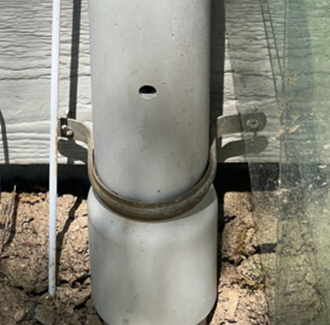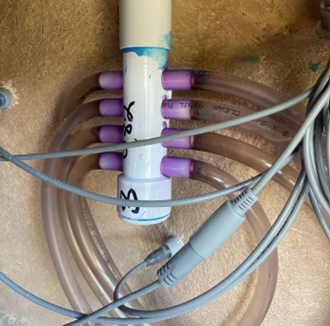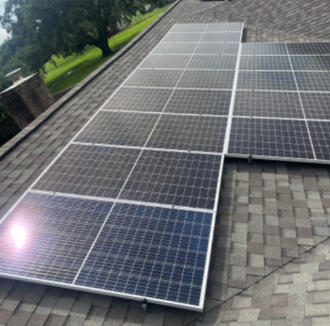Recategorized Causes of Loss
in Electrical Equipment Claims
In 2024, 61% of reported perils for electronics and electrically powered specialty items were recategorized following StrikeCheck’s objective assessment.
– The StrikeCheck 2024 Annual Claims Report
The discrepancy between the reported and actual causes of loss highlights the importance of an expert evaluation to accurately determine both the cause and scope of damage. These factors work together to ensure fair and precise claims outcomes. Even in cases where the losses are covered by policy language,* assessments help to adjusters to:
Ensure clarity
Prevent claims leakage
Avoid unnecessary payments for non-damaged items or unrelated perils
Scroll down to see real examples where assessments not only identified a different cause of loss but also refined the scope of damage, providing more accurate results for better-informed settlements.
Reported Cause of Loss: Foreign Object Impact
Claim Details: The policyholder reported that a neighbor’s trampoline impacted their roof, resulting in two holes. Included in the claim were several structural items, electrical wiring, an electrical outlet, and an electrical service panel.
The Assessment
Heavy rainfall accompanied the hurricane that reportedly blew the trampoline into the roof, and the holes in the roof allowed water to enter the house. During the assessment, the StrikeCheck technician tested the wiring, outlet, and service panel. The electrical service panel was working as designed, but the wiring was not transmitting proper voltage to the outlet.
Cause of Loss
Water from the roof penetrations damaged the electrical wiring. The service panel and electrical outlet were Non-Damaged.
StrikeCheck Recommendations
If coverage was afforded, the circuit within the electrical wiring that failed should be replaced to restore the wiring to pre-loss conditions. No action was required for the electrical service panel or outlet, but the StrikeCheck team recommended testing the outlet following the circuit’s replacement.
Claim Accuracy
Claimed Amount: $22,053
StrikeCheck Recommended Settlement: $563
Accuracy: $21,490
Learn More About 6 Questions That Affect Electronics Claims With Water Losses.
-faed24eb09bd8cfad9763abbc131b549fded13bb.png?v=05122025173824)
While the electrical outlet itself showed no signs of damage, a water-damaged circuit in the wiring failed to transmit voltage.
Reported Cause of Loss: Freezing Conditions
Claim Details: The adjuster submitted an assignment to StrikeCheck to look at a 4-foot exterior electrical service panel. They reported that water was pouring from the panel, and they needed to determine the cause of loss.
The Assessment
During onsite testing, the electrical service panel energized, distributed voltage as designed across the circuit breakers, and showed no other measured failures that could be attributed to freezing conditions. The technician noted a visible hole in the conduit entering the service panel, which seemed to be deliberate in nature. The policyholder claimed to have drilled the hole to drain water from the system, but StrikeCheck found no evidence of water damage.
Cause of Loss
The lack of evidence of damage related to either freezing conditions or water excluded them as causes of loss for the electrical service panel. The hole drilled by the policyholder into the conduit was Foreign Object Impact.
StrikeCheck Recommendations
If coverage was afforded, the conduit with the hole should be replaced. Full replacement of the service panel was not necessary to restore normal operation.
Claim Accuracy
Claimed Amount: $3,775
Recommended Settlement: $810
Accuracy: $2,675
Learn More About the Electrical Service Panels Through the Adjuster eBook.

The policyholder admitted to drilling the hole in a conduit entering the service panel, reportedly to drain water.
Reported Cause of Loss: Hail
Claim Details: The policyholder reported that several outlets in their kitchen were no longer working following a spring storm. They suspected hail had somehow damaged the electrical wiring, and the adjuster handling the claim turned to StrikeCheck to determine an accurate cause of loss.
The Assessment
The StrikeCheck team tested the outlets onsite and found that only one no longer received power. This was attributed to a circuit failure in the electrical wiring pathway. There was no evidence of hail damage, lightning damage, or any other storm-related peril impacting the electrical wiring.
Cause of Loss
The nature of the loss allowed StrikeCheck to eliminate hail, the reported cause of loss, as well as high voltage surge, lightning, and other similar events. The failed circuit was the result of Wear and Tear to the electrical wiring.
StrikeCheck Recommendations
If coverage was afforded, the failed circuit should be located via wire trace and a minor repair completed to return the wiring to pre-loss condition.
Claim Accuracy
Claimed Amount: $1,274
Recommended Settlement: $849
Accuracy: $425
Learn More About the Electrical System and Wires Through Our Guide.

A single kitchen outlet was not receiving power, but StrikeCheck’s assessment determined that hail, which the policyholder suspected, was not the cause of loss.
Reported Cause of Loss: Lightning or High Voltage Surge
Claim Details: A policyholder’s hot tub was not fully operational. The adjuster needed to know if the reported electrical failure was due to lightning, high voltage surge, or another cause of loss.
The Assessment
StrikeCheck’s technician noted a visible crack in the hot tub’s manifold that had allowed water to leak into the pump beneath. Because of the water damage, the pump tripped the circuit breaker when it cycled on. Despite the damage to the manifold and this pump, testing determined that other components, including additional pumps, were operating as intended.
Cause of Loss
Testing eliminated high voltage surge or lightning as a cause of loss. The manifold crack that allowed water to damage the hot tub’s pump was characteristic of cracks caused by Freezing Conditions.
StrikeCheck Recommendations
A full replacement of the hot tub was not necessary. If coverage was afforded, replacing the manifold and pump would be sufficient to correct the damage.
Claim Accuracy
Claimed Amount: $23,954
Recommended Settlement: $880
Accuracy: $23,074
Learn More About Hot Tubs in Finding the Correct Cause of Loss in Hot Tub Claims.

While the hot tub was determined to have some damage, none of the onsite evidence and testing indicated lightning or high voltage surge was the culprit.
Reported Cause of Loss: Smoke/Fire
Claim Details: A public adjuster reported that a deli’s exhaust hood no longer worked after a fire in the business next door. The adjuster handling the claim asked StrikeCheck to assess for soot damage and to determine if the hood system was operational. HVACi, another brand within Alpine Intel’s suite of services, also assessed the deli’s coolers for soot damage.
The Assessment
Onsite, boxes were piled on the exhaust hood, which indicated it was not in use. The system’s lighting kits were able to illuminate, and testing showed that the voltage distribution was appropriate throughout the exhaust hood. The StrikeCheck team found no damage to the electrical control components or motors. The interface panel’s display was distorted and inoperable.
Cause of Loss
StrikeCheck’s assessment revealed no evidence of soot or fire damage on the exhaust hood. The distortion and failure of the display panel were the result of incidental Foreign Object Impact.
StrikeCheck Recommendations
Because the other elements of the exhaust hood system were operating as intended, the system could be restored to pre-loss condition by replacing the damaged control panel with one of Like Kind and Quality.
Claim Accuracy
Claimed Amount: $ 21,001
Recommended Settlement: $ 1,436
Accuracy: $19,565
Read How Experts Assessed a Fire Loss in the HVAC and Electrical Items Fire Damage Case Study.

The distortion on the exhaust hood system’s display screen was not consistent with soot and fire damage, and other components of the system were not damaged.
Reported Cause of Loss: Wind
Claim Details: A homeowner told their carrier that their solar panels looked from the ground as though something had hit them, and a monitoring app had alerted them about a malfunction. The adjuster asked StrikeCheck to determine the true cause of loss to 32 solar panels and provide recommendations about next steps.
The Assessment
The StrikeCheck team accessed the roof to assess the solar panels and found that the two panels indicated by the monitoring app as not producing full power had visible cracks and shattered glass. The other 30 rooftop panels, string inverter, and electrical connections associated with the system showed no evidence of damage via testing, visual inspection, and thermal imaging.
Cause of Loss
The cracks and shattered glass on the two damaged solar panels were consistent with Hail impact, which prevented them from operating at full capacity.
StrikeCheck Recommendations
If coverage was afforded, replacing the two hail-damaged panels would restore the solar power system to normal operation. The other panels and solar equipment were non-damaged and required no action.
Claim Accuracy
Claimed Amount: $24,395
Recommended Settlement: $2,285
Accuracy: $22,110
Find Out What Adjusters Should Expect To See From Storm-Impacted Solar Power Systems.

While most of the house’s solar power system showed no signs of damage, there were visible signs of impact to two of the panels.
Thanks for Reading!
Determining both the cause of loss and the scope of damage is essential for accurate claim resolutions. Even when the losses fall under the policy, aligning these two factors can help adjusters minimize claims leakage and uphold the integrity of the claims process.